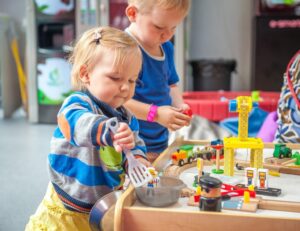Hi Everyone..! This is my first attempt to write this blog about – What Is Montessori Is? There are lot of myths about this topic and I am going to try to talk about some of them in this blog and in more upcoming ones too.
So, The Montessori method of education was developed by Dr. Maria Montessori, the first female Italian doctor in the early 20th century. She used her training as a scientist and doctor to carefully observe children and designed schooling that is meant to appeal to their nature rather than fight it.
For example, if kids like moving around, why not design schools that lets them move instead of making them stay seated? This is what she did with all the preconceived notions on how classrooms should look like – just because we always had desks doesn’t mean they have too!
So with this mindset, she designed the schools for children that appeal to them.
Foundational principles of Montessori Education
Now Lets Discuss few Foundational principles of Montessori education to give you better idea of What Montessori is:
1. Experimental learning:
Dr. Maria Montessori sought to revolutionize the way children learn by shifting from memorizing math facts and letters through repetition, to experiencing a hands-on approach. She observed that life is about moving and learning through experience rather than sitting still in a classroom listening passively.
In her “democratic schools”, there were no desks or chairs. Instead, students sat on floor mats at low tables while working with specially designed materials like little objects and wooden blocks known as movable alphabet toys.
2. Mixed age classrooms:
This is a very Interesting Idea. In a Montessori classroom, children of all ages and skill levels are mixed together. Because
This gives the little ones who learn by watching older peers to pick up skills much faster than they would have on their own while this also gives those more advanced students the invaluable leadership experience in teaching them.
3. Uninterrupted work period
Montessori schools provide a unique long work period for children that allows them to deeply engage with materials and reach intense concentration. The amount of time allotted, depending on age, ranges from 2-3 hours in one classroom where all subjects are taught together rather than having 30 minutes per subject every hour.
4. Academics:
Montessori schools are comprised of not only math, language arts and science but also two other academic areas: practical life skills and sensorial education. So, practical life encompasses exercises that help children learn how to use basic skills they will need throughout their lives such as tying shoes or pouring water carefully, tidy up their things, and so on.
And sensorial is the teaching of a child’s senses by exposing them to materials like colors or textures for example. Sensory education can be found in classrooms specifically designed for young children where it may take on forms including being able to see something with your eyes closed so you know what an object feels like without looking at its shape first.
5. Role of the teacher:
I personally like this approach as a Montessori teacher. A Montessori teacher is a guide, not just an instructor. Their job is to observe the children and introduce them to at just the right time with one-on-one attention provided in their absence. They does this through carefully crafted activities that are designed for each individual child’s abilities, while fostering independence and self-control so as they can later be responsible learners.
6. Freedom within limits:
The Montessori system is child-directed, means the children choose where to sit and what to work on. A teacher will give a lesson using materials she hasn’t taught before but then allow them to independently do it when they want with guidance from her as needed. For example, if an activity was about drawing shapes in math class, the student wouldn’t be allowed only draw all day or dance around distracting his friends while doing this new task – he could instead either take up pencils at a table or get comfortable sitting on the floor (or both!) based entirely upon which best suits him for that particular subject matter.
7. Educating the child:
Montessori’s focus on educating the whole child means that you might find a 3-year-old walking carefully over a line holding an oversized glass of water. You may also see them meditating or doing yoga as well, with children practicing subtraction nearby. Each component is considered equally important in Montessori teaching and these practices can help your young learner grow into both mentally balanced adults, while giving physical benefits too!
With these ideas and principles, Montessori education has been motivating children of all age groups and improving their lives.
Thanks,
Nidhi Sanghi


